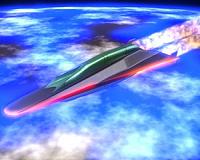 |
Arnold AFB TN (AFNS) Dec 30, 2009 A high-visibility test on a second-stage developmental rocket motor set a new record in the Arnold Engineering Development Center's J-6 large-rocket motor-testing facility Dec. 9. Joe Migliaccio, the Aerospace Testing Alliance engineer who conducted the test, said the team fired an Alliant Techsystems, Inc., or ATK, Castor 30 rocket motor for approximately two and a half minutes, which is longer than any previous rocket-motor test entry since the testing facility became operational in 1994. He explained that the motor's long burn time is essential to its primary mission. "The reason this rocket motor will burn more than some is its mission is to put payloads into space without imparting a great shock load," he said. "So, if you have a rocket motor that's designed for an intercontinental ballistic missile application, you're boosting a warhead to get it up and out in a hurry. The burn times are (longer) if you're boosting a satellite payload that needs a softer ride. So, if you get a softer ride, you get a longer burn time and a thrust curve that looks more like a bell instead of a square wave." Three officials with ATK, a Minneapolis-based weapon and space systems developer, were onsite to view the test of their company's rocket motor first-hand. They said the successful run validated a "critical" component that their customer, Orbital Sciences Corp., will use in their Taurus II medium-class launch vehicle. "This test was the first static fire of the Castor 30 motor," said Kevin Enright, ATK's program manager for the Castor 30 rocket motor. "We've done a lot of testing (on) sub-scale levels with propellant and with the cases built up with the new thrust vector control system, but this is the first full-scale static test of this rocket motor." Also viewing the test onsite was Lt. Col. James Colebank, the commander of the 718th Test Squadron, the unit that manages the facility to provide the correct environment to simulate the high altitude conditions for the Castor 30 rocket motor. "This test is significant to the Air Force because the technology can be used to support some of the Air Force weapons systems in development," he said. "Also, it's very important to the nation because this motor can be used to launch satellites and provide commercial launch services to re-supply the International Space Station." Scott Lehr, ATK's vice president and general manager of strategic and commercial systems described AEDC as a "national treasure" and said today's test was a milestone for his company. "This test today (pending final analysis of all the data) will release us to go on to build the first three production copies of this motor," he explained. "So, for us, (this test is) a big deal." Andy Jackson, ATK's director of commercial launch capability, said he, along with representatives from Orbital Sciences Corp., Moog Corp. and NASA were all excited to be on hand for the test. "This stage actually is going to reside in ATK's commercial motor family," he said. "We have what we call a family of motors, where we can take different motors and different configurations and assemble them into launch vehicles for different needs. "So, this filled a niche in our family of motors," he continued. "We've got a couple of applications right now and we're hoping to advance it to different applications in the future. We've been at this program for about three years. This is a big test with the first static fire and with this, kind of like the field of dreams; you build it they'll come." Mike Laidley, with Orbital Sciences Corp., felt fortunate to be present for the rocket motor test. "We're developing this Taurus II medium class launch vehicle rocket to support future commercial and space mission resupply missions," he said. "The first launch of Taurus II will be in March 2011 in support of the Commercial Orbital Transportation Services demonstration mission. We're building these vehicles in support of space station resupply." For Debra Ocejo, a propulsion engineer with Oribital, this was her first visit to AEDC. "The nice thing is actually being able to see data to validate all the design and all the effort that ATK has done in their reviews up until this point and to actually see a completed motor, then see it fire," she said. "For an engineer, this is Christmas and New Years rolled into one. We get to open the present and there's a lot of smoke and fire."
Share This Article With Planet Earth
Related Links - Rocket Science News at Space-Travel.Com
 New Materials Designed To Deal With Hypersonic And Supersonic Hot Stuff
New Materials Designed To Deal With Hypersonic And Supersonic Hot StuffBrisbane, Australia (SPX) Dec 28, 2009 University of Queensland researchers are testing new materials to withstand the extreme heat experienced by hypersonic vehicles in flight so they can fly for substantially longer. Previous Australian experimental flight tests of scramjets, a type of very fast jet engine, have not lasted longer than five seconds. The tests, conducted at Woomera in South Australia over the past eight years, have used scramjet engines made of conventional materials which have problems with extreme heat including melting, and are not designed for re-use. ... read more |
|
| The content herein, unless otherwise known to be public domain, are Copyright 1995-2009 - SpaceDaily. AFP and UPI Wire Stories are copyright Agence France-Presse and United Press International. ESA Portal Reports are copyright European Space Agency. All NASA sourced material is public domain. Additional copyrights may apply in whole or part to other bona fide parties. Advertising does not imply endorsement,agreement or approval of any opinions, statements or information provided by SpaceDaily on any Web page published or hosted by SpaceDaily. Privacy Statement |